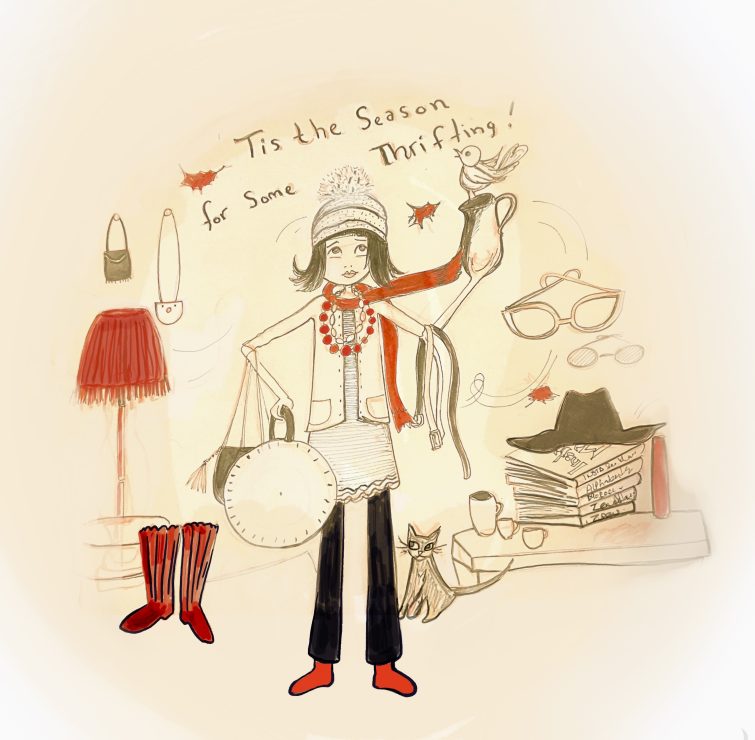Thrifting will not put an end to overconsumption

Illustration by Freyja Zazu.
Many students look to thrift stores to spruce up their wardrobes because their prices are lower than retail stores and they might be aware of the negative impact that fast fashion has on the environment. In 2018, fashion accounted for nearly 20 per cent of global wastewater and 10 per cent of global carbon emissions.
The term thrifting gets thrown around a lot in the online sustainable fashion community, and buying second-hand clothing instead of new is often promoted by influencers and climate activists as a way to reduce our carbon footprint. However, thrifting can still negatively affect the environment as unsold donations are shipped to other countries, and it contributes to the problem of overconsumption in our culture. Learning to sew or joining a local online clothing swap group are actually better for the environment.
I’m not going to lie, I started thrifting because it was “cool” and a fun activity to do with friends. I believed buying second-hand clothing was better for my shopping addiction as it is less expensive, and I thought I wasn’t supporting fast fashion.
Ultimately, thrifting can promote a mindset of overconsumption. It may encourage us to buy clothes whenever we want, even if they are used. We might believe that by getting rid of our old clothes by adding them to a pile of donations it relieves ourselves from guilt, hoping they do some good.
However, only 10 to 30 per cent of clothing donations are actually sold in thrift stores. The remaining used clothing is sold and exported overseas to countries such as Pakistan, India, and Chile. At both Value Village and the Salvation Army, approximately five per cent of donations end up in landfills.
Countries that rely on the second-hand market also indirectly rely on the rapid production of new clothing and overconsumption in the west.
Thrift stores are so well-stocked because of the speed at which fashion trends are cycled through. Thrifting does not put an end to the overproduction that sustains the second-hand market.
I used to think I was helping the environment because I was buying second-hand clothes. But I’ve since learned that, rather than spending the same amount of money on used clothes instead of new, we should aim to buy less overall.
According to Value Village’s 2022 Thrift Report, 92 per cent of consumers will spend as much or more on second-hand clothing compared to their current spending. Additionally, 83 per cent of consumers engaged with thrift stores: 56 per cent as donors, 3 per cent as shoppers, and 24 per cent as both. This suggests donations far exceed the goods purchased by consumers.
Buying second-hand clothing does reduce waste as it prolongs the life-span of garments, and it bypasses the production stage. To make just one t-shirt it takes approximately 10 Kilowatt-hours of energy with an average carbon footprint of 7 kg CO2 equivalent, making thrifting a better alternative to buying new clothing. However, shopping in your own closet first is the best thing to do.
We need to get in the habit of reflecting before making a purchase, asking ourselves if the item is something we need and will actually wear over and over again. Otherwise, you’ll end up dropping lots of your unwanted clothing at thrift stores, contributing to the cycle.
Thrift stores have proposed what appears to be such a simple solution to a problem that has gotten out of hand. The practice became popular so quickly, but the conversation and focus really needs to be on the root problem itself.
I think fashion can be a great way to be creative. But at what cost? Maybe it’s time for a new hobby.
Finding new ways to style, mending or upcycling old clothes, can be creatively fulfilling and allow you to re-wear a garment as many times as possible. Borrowing from friends or family is another great option, just make sure you ask first.
Sure, you won’t get the rush of finding something for a great price or a hidden gem in the thrift store, but you also won’t face the guilt that comes after. Remember, the piece of clothing you already own is the most sustainable piece of clothing.








